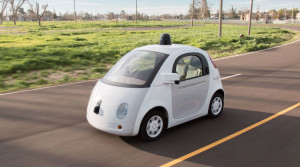The promise behind self-driving vehicles has been around for many years and each year, we seem to take one step closer to having the option to kick back while the vehicle does the driving. In January 2015, things took a huge step forward when several automakers announced that they would have a self-driving vehicle on the road somewhere between 2017 and 2020. However, Google has had a driverless car in the works since 2010. In April 2014, Google announced that they had logged in approximately 700,000 autonomous miles. By late May, they had developed a new prototype vehicle to try; one that is 100% autonomous. They stated it would have no steering wheel, brake pedal, or gas pedal. This too has now become a reality.
The Google Self Driving Car
As of right now, Google’s new car invention is kind of a bubble on wheels. Inside the prototype that has no steering wheels, brakes, or pedals of any kind, there is room for two people and a dog.

It is designed to be “cute” with a face and all. Its top speed is 25mph however, Google hopes to increase the speed after more testing is done to ensure safety. They hope that by the time the public has easy access to it, it will be able to run safely at 100mph.
Is It Safe?
When common, everyday drivers are asked about their concerns for an autonomous car, most people mention safety. Is it safe to be inside of? What happens if a sensor fails? Is there any potential for someone to hack into the car’s system? Not all of these concerns have been alleviated as of yet. It is something that Google, as well as other vehicle manufacturers will have to confront before these vehicles are in the hands of everyday people.
However, out of more than 700,000 logged in automatic driverless car test runs and 23 self-driving vehicles on the road, it does seem that Google cars are safe. There have only been 11 minor traffic accidents on public roads. In all cases, it was not the driverless vehicle at fault. The accidents happened while the car was being driven manually or because of another vehicle doing the wrong things, including the time when it was rear-ended while sitting at a red light.
What Have Other “Riders” Noticed?
One rider in a Google car states that the car has trouble in situations where even human drivers would question what they should do. For instance, a pedestrian standing too close to the edge of the road will throw the vehicle’s sensors out of shape a little. There could end up being a situation where the car will not move because of the pedestrian and the pedestrian will not move because of the vehicle.
The others who have ridden in a driverless vehicle state that they feel safe inside of the car. The vehicle pays much more attention to its surroundings than typical drivers who are talking, texting, and dancing in their seats. Most feel that the roads would be safer if more vehicles had the power to take the steering wheel away from their negligent drivers’ hands. It is coming closer by the day and even Google plans to have it available for the public within the next five years.